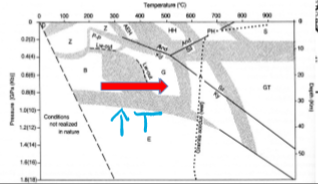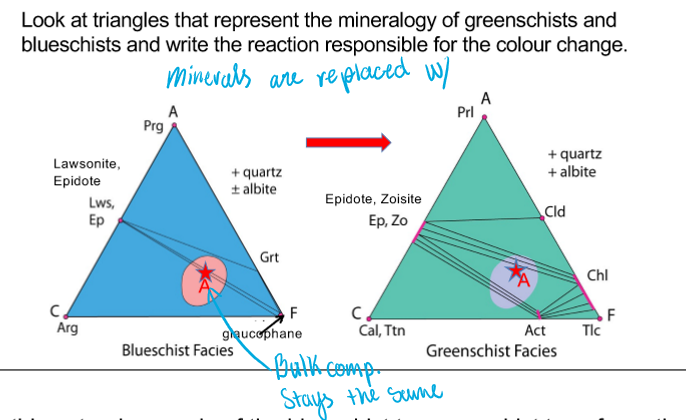L19 - Metamorphic Series, Metamorphic Belts, and reactions in Triangles
1/29
There's no tags or description
Looks like no tags are added yet.
Name | Mastery | Learn | Test | Matching | Spaced |
|---|
No study sessions yet.
30 Terms
What are the 2 types of Metamorphic Field Gradients (MFG)?
Buchan
Barrovian
What is a Facies Series?
a common sequence of metamorphic facies associated with progressive metamorphism.
What environment/process is associated with orogenic belt?
Barrovian series
What environment/process is associated with high heat flow orogenic belt?
Buchan series
What environment/process is associated with subduction zones?
Blueschist series - where heat flow is depressed by cold slabs
What is a high pressure series?
The blueshist series
What is the medium pressure series?
Barrovian series
What is the low-pressure series?
Buchan and abukuma
What is the high temperature series?
Hornfels series
What is the change in temperature per km in the blueschist series?
5 deg/km
What is the change in temperature in degrees celsius per km of the Barrovian series?
25 deg/km
What is a paired metamorphic belt?
The spatial association of metamorphic terranes that belong to the blueschist series and the Buchan (low-P) series
OR
the metamorphic expression of the varied heat flow in the active areas of subduction
Where were paired metamorphic belts first discovered?
First discovered in Japan
How many kms do belts typically stretch?
200-500kms
How are Buchan and Blueschist series spatially arranged?
Low-P metamorphic belt (Buchan series) is always on the inland side
High -P metamorphic belt blueschist series is always on the ocean side
How many kms are High-P Blueschist and Low-P Buchan separated by?
100-250 km wide
What are Paired Metamorphic belts characterized by?
Sodic amphiboles (Glaucophane)
What lead scientists to believe that Paired metamorphic belts are associated with subduction?
Resemblance to the Ring of Fire
Where is the High-P zone located in a in a Paired Metamorphic Belt?
Located between the subduction zone and the island or magmatic arc
Where is the Low-P zone located in a Paired Meta. Belt?
n*100 km further inland from the plate margin
What are the Paired Meta. Belts parallel to?
Parallel to the plate boundary over extended distances
What is one way to use Paired Metamorphic knowledge?
To tell the direction and age of ancient subduction zones
Why don’t all subduction zones have blueschists? Why are ancient belts rarer than recent ones?
require special conditions and rapid exhumation.
prolonged heating will eventually destroy high-P assemblages
must be removed quickly (metastability) or turns into amphibole facies rocks
What do blueschist turn into when heating?
Greenschists

What is an example of the transformation of Blueschist to greenschists on heating?
The Alps
What are the characteristics of Lawsonite
CaAl2Si2O7(OH)2 * H2O
Hydrous
calcium aluminum mineral
sorosilicate
8 on Mohs scale (exceeds quartz)
High-P polymorph is aragonite
What is the reaction from Glaucophane to Chlorite?
Lawsonite/ epidote + glaucophane → Actinolite +Zoisite/Epidote + Chlorite
Since star is not on thin line, therefore, Actinolite exists

What triangle is commonly used for metabasites?
ACF triangle
How can you tell if a mineral is unstable in a certain series using a triangle?
if there are no tie lines connected to it
What is one thing to keep an eye on when writing elemental substitutions?
Keeping charge balance